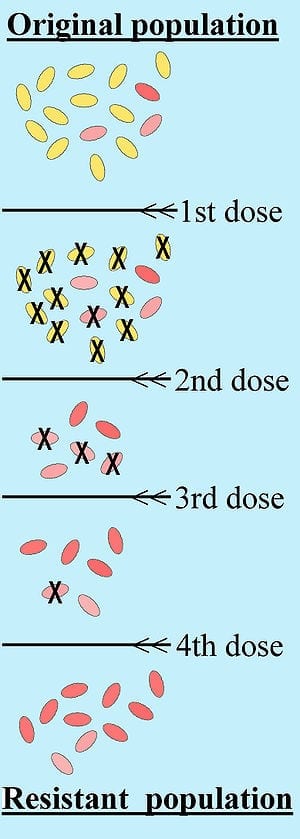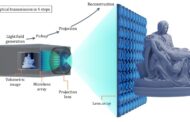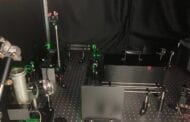
Fluorescent light traveling through polymer sheet may lead to user interface devices that respond to gestures alone
Digital cameras, medical scanners, and other imaging technologies have advanced considerably during the past decade. Continuing this pace of innovation, an Austrian research team has developed an entirely new way of capturing images based on a flat, flexible, transparent, and potentially disposable polymer sheet. The team describes their new device and its possible applications in a paper published today in the Optical Society’s (OSA) open-access journal Optics Express.
The new imager, which resembles a flexible plastic film, uses fluorescent particles to capture incoming light and channel a portion of it to an array of sensors framing the sheet. With no electronics or internal components, the imager’s elegant design makes it ideal for a new breed of imaging technologies, including user interface devices that can respond not to a touch, but merely to a simple gesture.
“To our knowledge, we are the first to present an image sensor that is fully transparent – no integrated microstructures, such as circuits – and is flexible and scalable at the same time,” says Oliver Bimber of the Johannes Kepler University Linz in Austria, co-author of the Optics Express paper.
The sensor is based on a polymer film known as a luminescent concentrator (LC), which is suffused with tiny fluorescent particles that absorb a very specific wavelength (blue light for example) and then reemit it at a longer wavelength (green light for example). Some of the reemitted fluorescent light is scattered out of the imager, but a portion of it travels throughout the interior of the film to the outer edges, where arrays of optical sensors (similar to 1-D pinhole cameras) capture the light. A computer then combines the signals to create a gray-scale image. “With fluorescence, a portion of the light that is reemitted actually stays inside the film,” says Bimber. “This is the basic principle of our sensor.”
For the luminescent concentrator to work as an imager, Bimber and his colleagues had to determine precisely where light was falling across the entire surface of the film. This was the major technical challenge because the polymer sheet cannot be divided into individual pixels like the CCD camera inside a smartphone. Instead, fluorescent light from all points across its surface travels to all the edge sensors. Calculating where each bit of light entered the imager would be like determining where along a subway line a passenger got on after the train reached its final destination and all the passengers exited at once.
The solution came from the phenomenon of light attenuation, or dimming, as it travels through the polymer. The longer it travels, the dimmer it becomes. So by measuring the relative brightness of light reaching the sensor array, it was possible to calculate where the light entered the film. This same principle has already been employed in an input device that tracks the location of a single laser point on a screen.
The researchers were able to scale up this basic principle by measuring how much light arrives from every direction at each position on the image sensor at the film’s edge. They could then reconstruct the image by using a technique similar to X-ray computed tomography, more commonly known as a CT scan.
“In CT technology, it’s impossible to reconstruct an image from a single measurement of X-ray attenuation along one scanning direction alone,” says Bimber. “With a multiple of these measurements taken at different positions and directions, however, this becomes possible. Our system works in the same way, but where CT uses X-rays, our technique uses visible light.”
The Latest Bing News on:
Imaging device
- United Imaging Healthcare Co., Ltd.: United Imaging Healthcare releases 2023 annual report, with revenue growth of 23.52%on April 26, 2024 at 8:18 am
Along with the publication of its 2023 annual report and the Q1 2024 report, United Imaging Healthcare released its ESG report. SHANGHAI, April 26, 2024 /PRNewswire/ -- United Imaging Healthcare ...
- United Imaging Healthcare releases 2023 annual report, with revenue growth of 23.52%on April 26, 2024 at 8:00 am
United Imaging Healthcare (SSE:688271), a global leader in manufacturing advanced medical imaging and radiotherapy equipment, has released their 2023 annual report. The report reveals that the company ...
- Electromedical Devices Market Strategic Voices Amplifying Impact with Effective Focus Group Strategieson April 25, 2024 at 9:44 pm
Electromedical Devices Market is valued at approximately USD 44.3 billion in 2019 and is anticipated to grow with a healthy growth rate of more than 7.2% over the forecast period 2020-2027.
- Philips receives FDA warning letter over imaging systems manufactured in Chinaon April 25, 2024 at 11:10 am
The FDA published a warning letter that it sent to Philips (NYSE:PHG) that outlines issues around imaging technology manufacturing practices.
- Medical Imaging Devices Market: Today and Over the Next 10 Years (2024-2034)on April 25, 2024 at 6:47 am
The "Medical Imaging Devices Market Report 2024-2034" report has been added to ResearchAndMarkets.com's offering.Overall world revenue for Medical Imaging Devices Market, 2023 to 2034 in terms of ...
- Trailblazing sonar device will be in thousands of Minnesota boats for fishing openeron April 25, 2024 at 5:17 am
The futuristic "forward-facing sonar" is here and much more common. One impact: Releasing some fish might become necessary as catch rates improve.
- Artificial Intelligence Makes Retinal Imaging 100 Times Fasteron April 24, 2024 at 1:19 am
AI enhances high-res eye imaging for quicker and clearer evaluation of age-related macular degeneration and retinal diseases.
- International Contrast Ultrasound Society (ICUS) and Northwest Imaging Forums announce partnership to advance IV training for sonographerson April 23, 2024 at 10:41 am
The International Contrast Ultrasound Society (ICUS) and Northwest Imaging Forums (NWIF) today announced an educational partnership to help train sono ...
- ThinkSono Releases Real-Time DVT AI Training Solution for Butterfly Network's Handheld Ultrasound Deviceson April 23, 2024 at 7:01 am
LONDON, ENGLAND / ACCESSWIRE / April 23, 2024 / ThinkSono, a pioneering provider of AI-driven medical imaging solutions, is proud to announce the ...
- FDA Approves Drug-Device Combo to Detect Residual Cancer After Lumpectomyon April 17, 2024 at 5:00 pm
Lumisight is used with the Lumicell Direct Visualization System (DVS) or another fluorescence imaging device approved for use with pegulicianine in the indicated population. The approval was supported ...
The Latest Google Headlines on:
Imaging device
[google_news title=”” keyword=”imaging device” num_posts=”10″ blurb_length=”0″ show_thumb=”left”]
[/vc_column_text]
The Latest Bing News on:
Image sensor
- Philips 5000 series indoor 360° camera launched: Price, image quality and all featureson April 26, 2024 at 7:32 am
Philips 5000 series indoor 360° camera offers the flexibility to opt for continuous recording using a microSD card of up to 128GB, facilitating uninterrupted surveillance even without Wi-Fi ...
- How your phone's fingerprint sensor workson April 25, 2024 at 6:58 am
Most smartphones use capacitive or ultrasonic fingerprint sensors for authentication. The technologies are a little different, but both work well.
- Best full-frame camera 2024: the top big sensor DSLRs and mirrorless camerason April 23, 2024 at 10:10 am
Full-frame is still regarded as the holy grail of sensor formats in 2024’s mirrorless and DSLR cameras, with the latest and greatest models offering superb image quality in any light and speedy ...
- Huawei Mate 70 series to feature China-developed image sensors for its main camerason April 23, 2024 at 2:00 am
Tech blogger Digital Chat Station revealed on Chinese social media platform Weibo yesterday that Huawei’s next-gen flagship Mate 70 series smartphones ...
- Moment T-series review: premium build quality but limited image gainson April 22, 2024 at 7:07 am
Moment's T-series lenses are well-built, offering the look and feel of a premium product. But with high-end smartphone cameras getting so good, can they still up your photo game? We decided to find ...
- Organic CMOS Image Sensor Market Segmentation Synergy Strategies for Identifying and Targeting Your Market Effectivelyon April 21, 2024 at 10:10 pm
Request To Download Free Sample of This Strategic Report @- Organic CMOS image sensor technology uses organic photoelectric conversion layer with high absorption coefficient, providing wider incident ...
- Organic CMOS Image Sensor Market Size Explorer’s Journey into Growth Navigationon April 21, 2024 at 2:06 pm
Report Ocean recently added a research report on “Organic CMOS Image Sensor Market”. The report includes an extensive analysis of the market’s characteristics, COVID-19 impact, size and growth, ...
- Researchers develop display screens with biometric sensor capabilitieson April 19, 2024 at 10:54 am
Traditional display screens like those built into smartphones require extra sensors for touch control, ambient light, and fingerprint sensing.
- CMOS Image Sensorson April 18, 2024 at 11:31 am
The Emerald Gen2 is the newest addition to Teledyne’s CMOS image sensor family. Emerald Gen2 is available in 8.9-megapixels or 12-megapixels, in monochrome or color, and in two-speed grades, standard ...
- Zhuhai Chuangfeixin: OTP IP Based on 90nm CMOS Image Sensor Process Technology Successfully Mass Productionon April 17, 2024 at 3:49 am
Zhuhai Chuangfeixin Technology Co., Ltd.,(CFX) a leading one-stop NVM IP provider in China, recently announced that its OTP IP (One-Time Programmable memory IP core) for 90nm CMOS Image Sensor (CIS) ...
The Latest Google Headlines on:
Image sensor
[google_news title=”” keyword=”image sensor” num_posts=”10″ blurb_length=”0″ show_thumb=”left”]







